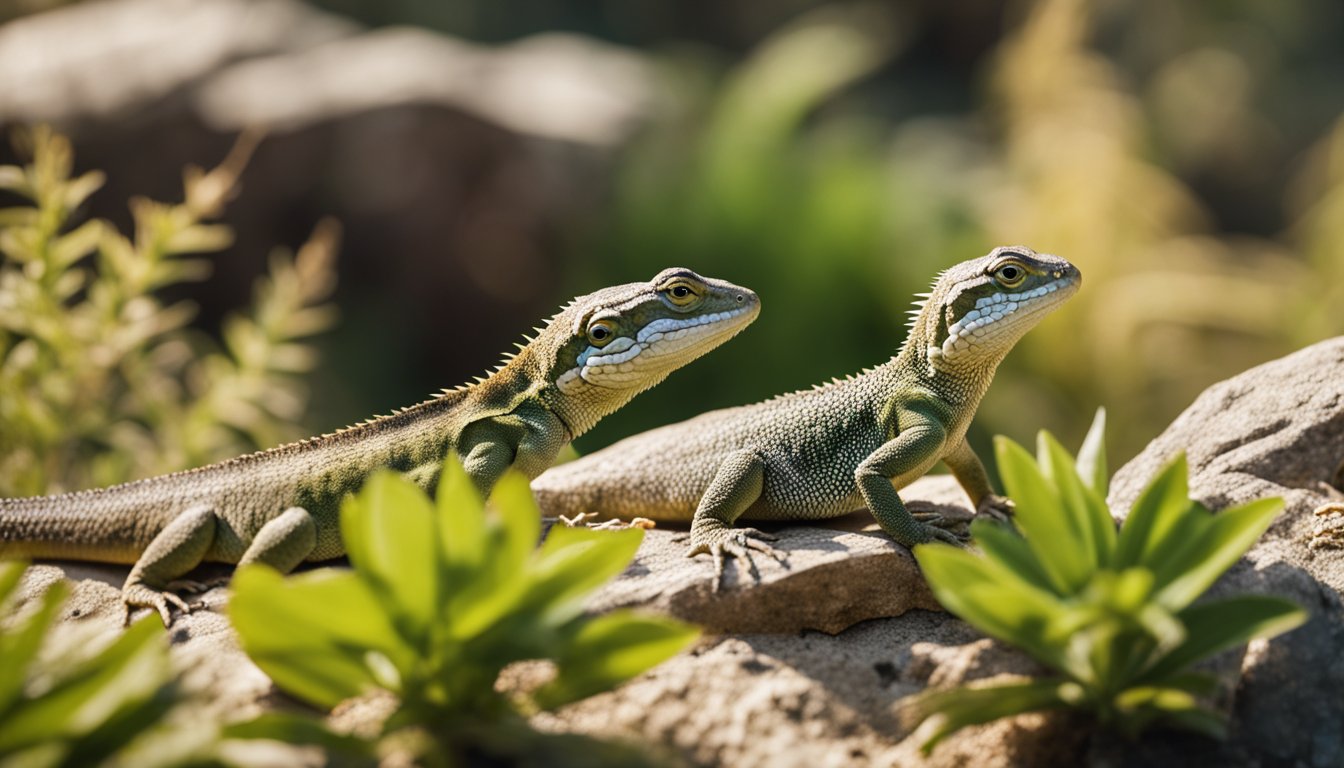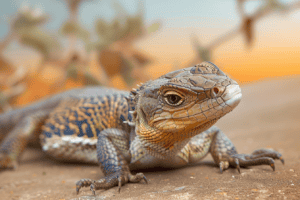Lizards are a bustling group of reptiles that are known for their love of soaking up the sun.
With their scaly skins and often vibrant colors, these creatures can be found basking on rocks, walls, and in forests around the world.
Their affinity for sunshine isn’t just a matter of preference; it’s crucial for their survival.
As cold-blooded animals, lizards rely on external heat sources to regulate their body temperature.
This process of warming themselves not only energizes them but also aids in digestion and helps them stay alert for any danger that may lurk nearby.
Observing lizards in their sunny habitats is like watching miniature dragons living out their own adventures.
They come in all shapes and sizes, from the tiny geckos that might scamper across a living room wall to the impressive Komodo dragons that dominate their island ecosystems.
Each species has its own unique set of adaptations that allow it to thrive under the sun.
Some have evolved intricate patterns on their skins that help them blend into their surroundings, while others sport dazzling colors that warn predators to stay away.
As they flit about under the sun’s rays, these lively reptiles also play an important role in the ecosystems they inhabit.
They act as both predator and prey, maintaining a delicate balance in the food chain.
A lizard’s diet is as varied as their appearance, munching on everything from pesky insects to plants, which makes them a gardener’s ally.
Some species are even known to be great companions at home, catching bugs that otherwise might pester humans.
With so many intriguing facts, it’s no wonder lizards have captivated the interest of people of all ages.
Exploring the Sun-Loving Lizards’ Habitat
Sun-loving lizards thrive in environments where the rays of the sun are abundant and the warmth of the day fuels their activities.
The habitats they favor are as varied as the lizards themselves, each offering unique conditions that cater to their sun-basking needs.
Diverse Dwellings
These creatures seek out habitats that support their thermoregulatory behavior, ranging from tropical rainforests to arid deserts.
One might find them skillfully navigating the dense foliage of a humid jungle, where dappled sunlight filters through the canopy overhead.
In contrast, others have adapted to the sparse vegetation and open landscapes of the desert, where sunlight is plentiful and shade scarce.
Forested areas present another dwelling option, with some lizards using the sunlit clearings to bask, while others perch high on branches, absorbing the sun’s warmth.
The Climate Connection
The relationship between sun-loving lizards and their environment is closely tied to the climate of the region.
They are most commonly found in areas where the temperatures are warm enough to facilitate their necessary basking behavior.
For example, the Galápagos marine iguana relies on the Equator’s consistent sunshine to regulate its body temperature.
Meanwhile, the Australian bearded dragon endures the scorching heat of the outback, retreating to cool burrows when the sun reaches its peak.
The commonality they share is the need for a habitat that provides both exposure to sunlight and opportunities for shade to avoid overheating.
Anatomy and Adaptations
Sun-loving lizards possess fascinating features that equip them for their bright environments.
Their anatomy and unique adaptations are essentials for their survival, letting them bask in the sunshine while handling the challenges that come with it.
Skin and Scales
Lizards boast a protective outer layer of skin covered in scales, which functions like a suit of armor against predators and harsh conditions.
These scales are made of keratin, the same material found in human fingernails and hair.
Depending on the lizard species, the scales can be smooth, keeled (ridged), or spiny, each providing different levels of protection and camouflage.
Some lizards can even change the color of their scales to blend into their surroundings, a clever trick to avoid predators or ambush prey.
The color and brightness of their scales are not just for show; they can reflect harmful ultraviolet rays while absorbing essential sunlight.
This sunlight is crucial as it assists in the production of vitamin D, important for regulating their metabolism and calcium for strong bones.
Thermoregulation Tactics
Unlike humans, who can regulate their body temperature internally, lizards are ectothermic animals, meaning they rely on external heat sources to control their body temperature.
They have a suite of behavioral adaptations to manage their internal thermometer.
On cool mornings, they may be found sprawled out on a warm rock, soaking up the sun’s rays to increase their body temperature; this is known as basking.
When the midday sun becomes too intense, these clever creatures will seek shade or burrow into the cool earth to lower their body temperatures.
Some lizards have developed blood flow adjustments that help direct more blood to the surfaces of their bodies when they need to warm up, and less when they need to cool down.
This way, they can stay active and hunt for food when other animals might be forced to find respite from the heat.
Diet and Hunting Methods
Sun-loving lizards are fascinating creatures with intriguing ways of finding and enjoying their meals.
They show great diversity in their diet choices and employ clever tactics to hunt down their prey.
Feeding Frenzy
The diet of sun-loving lizards varies widely among different species, but commonly they enjoy munching on insects, spiders, and other small arthropods that they find while basking in the sun.
They have excellent vision that aids them in spotting a feast from a distance.
For example, a bearded dragon will eagerly consume crickets or worms with rapid flicks of its sticky tongue.
Iguanas, on the other hand, primarily feast on leafy greens, showing that not all lizards are carnivores.
The Art of Ambush
When it comes to hunting, many lizards are masters of stealth.
They use a sit-and-wait strategy, where they remain motionless and blend into their surroundings until an unsuspecting prey comes by.
A classic example is the chameleon, which can stay utterly still for a long time, then surprise its meal with its swift, projectile tongue.
The ability to camouflage offers them the perfect disguise to ambush their next snack, demonstrating a remarkable adaptation for survival.
Frequently Asked Questions
Discover the secrets of sun-loving lizards through these commonly asked questions.
They’ll help shed light on why these reptiles seek the sun, their distinctive features, favored habitats, diets, and remarkable adaptability.
Plus, get ready for some quirky tidbits that’ll have you looking at lizards in a whole new way!
Why do lizards bask in the sun?
Lizards bask in the sun because they are ectothermic, which means their body temperature depends on their surroundings.
This sunbathing ritual helps them warm up to an optimal temperature for hunting, digesting food, and being active.
What are some unique features of lizards?
Lizards possess a variety of unique features, such as the ability to detach their tails to escape predators, known as autotomy.
Another fascinating trait is their skin, which can camouflage and blend in with their environment to hide from threats or ambush their prey.
What kind of habitats do lizards love the most?
Lizards thrive in diverse habitats, from arid deserts to lush jungles.
They love environments where they can effectively regulate their temperature, with plenty of sunlight, shade, and shelter.
Rocks, tree branches, and underbrush offer perfect spots for their sunbathing and resting needs.
What do young explorers need to know about lizard diets?
Young explorers should know that lizards are primarily insectivores, which means they eat insects.
Some larger species may also consume fruits, leaves, and even other smaller lizards or rodents, making their diet quite varied depending on their species and habitat.
How do lizards adapt to their environments?
Lizards demonstrate incredible adaptability to their environments through various means.
They can change color, move swiftly through different terrains, and some species can even glide short distances.
These remarkable adaptations help them survive and thrive in their respective ecosystems.
Can you share some fun and surprising lizard facts for kids?
Certainly! Did you know that the Gecko can stick to almost any surface, including glass, due to the microscopic hairs on its feet?
Or that some lizards can squirt blood from their eyes to startle predators?
These are just a couple of the incredible and fun facts that make lizards so interesting.









